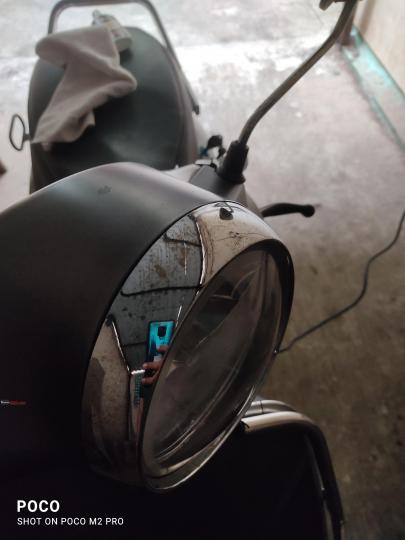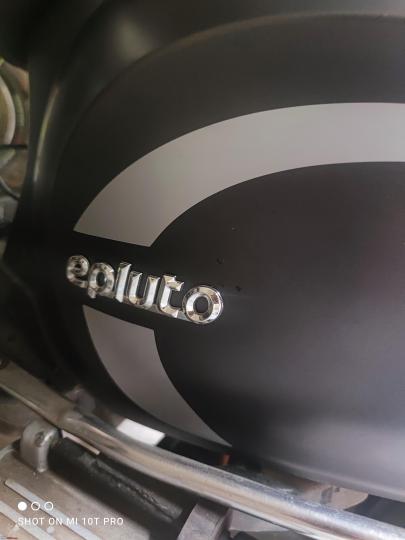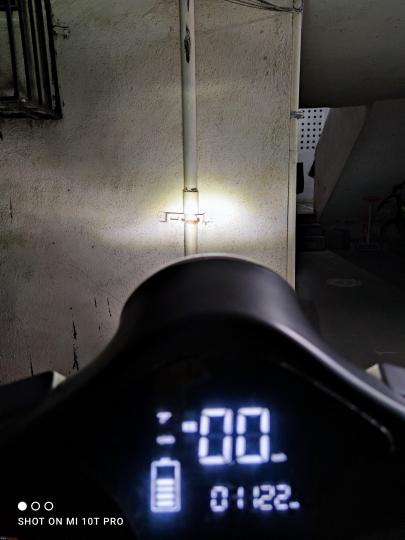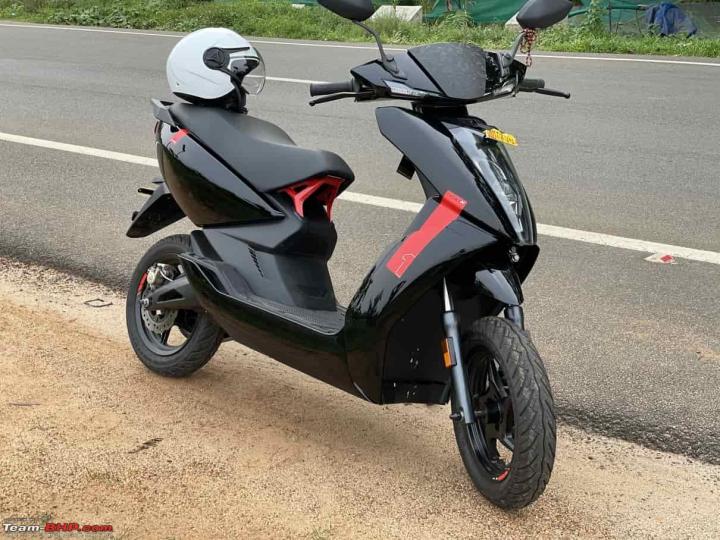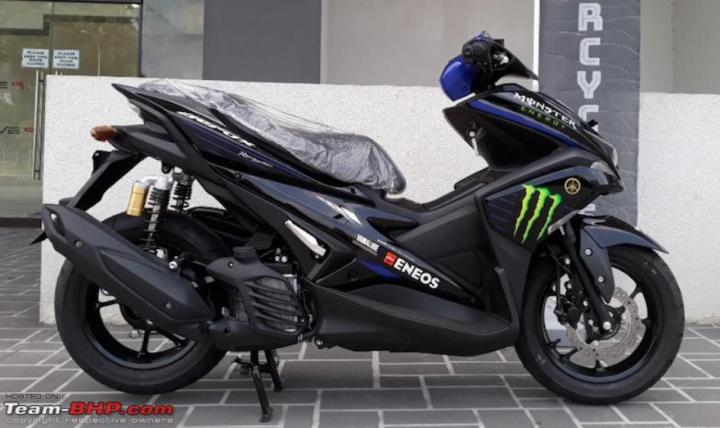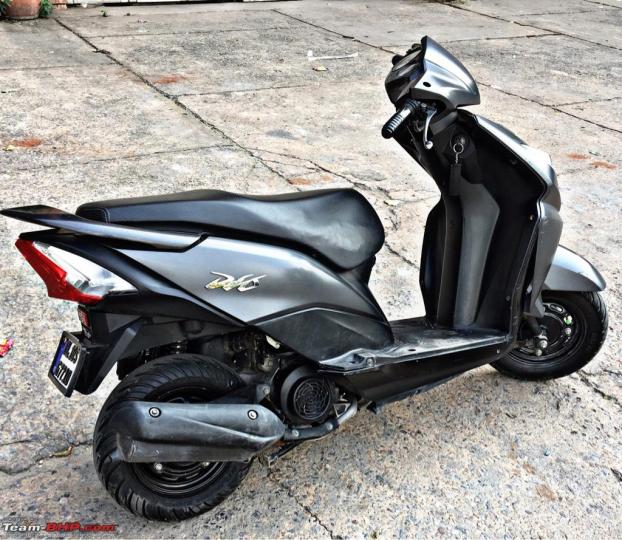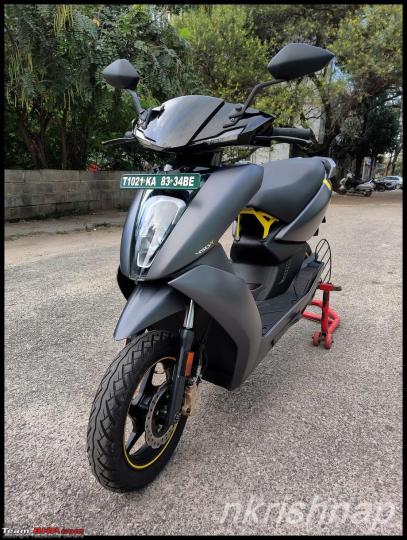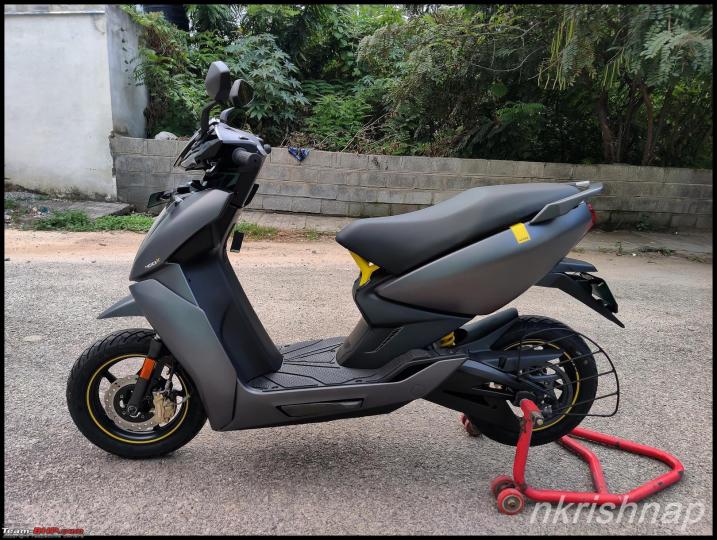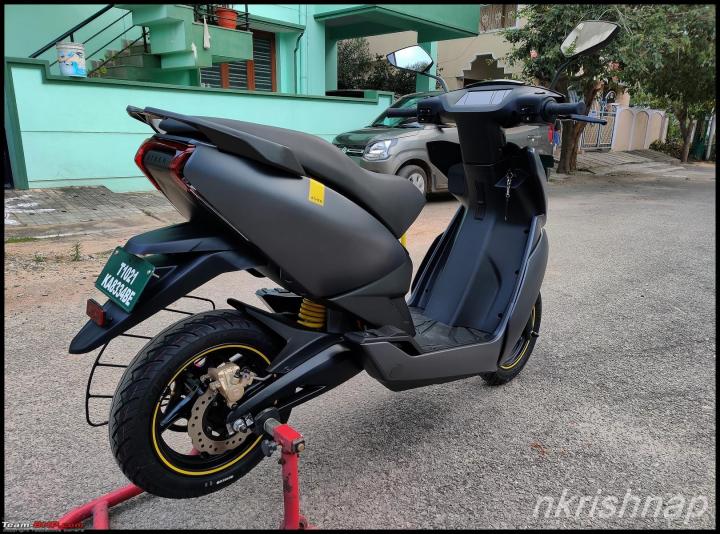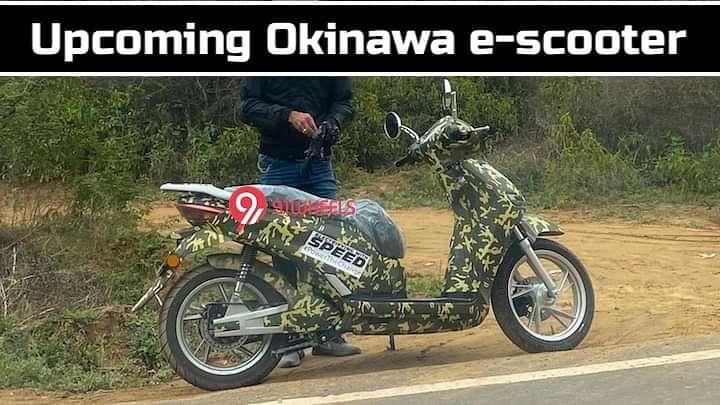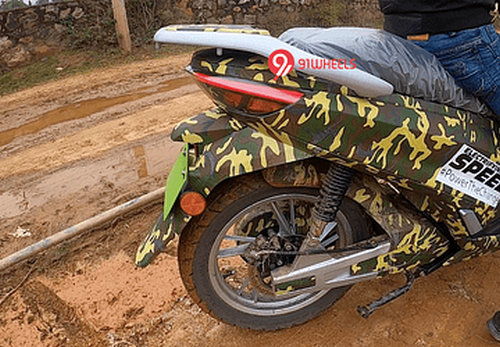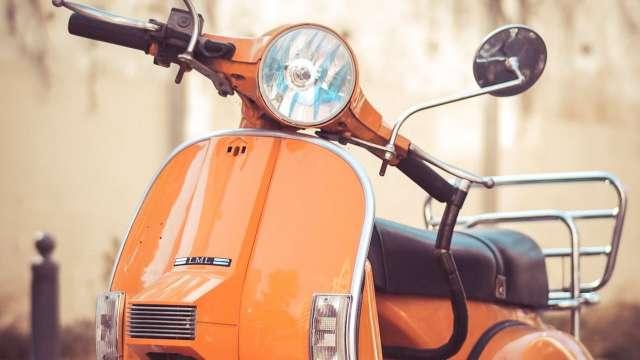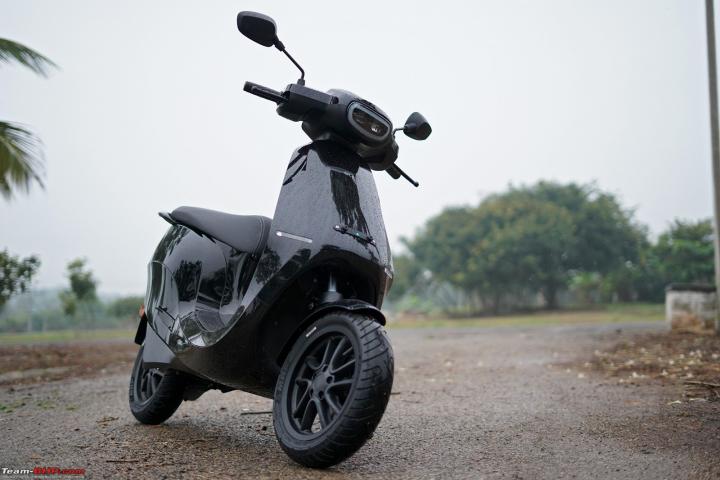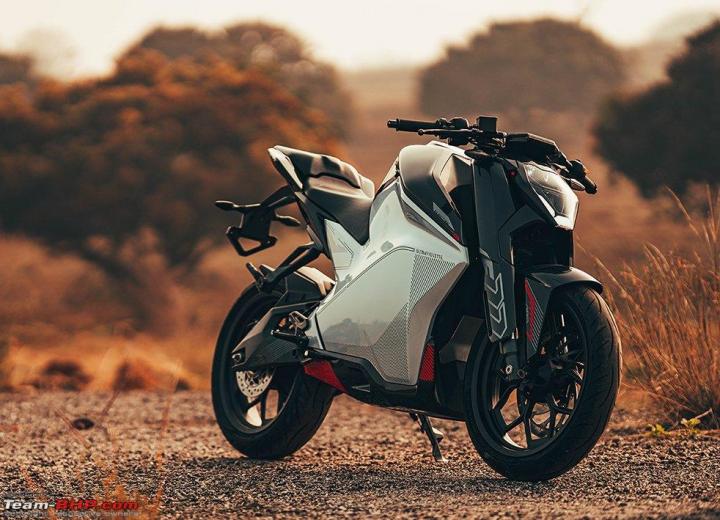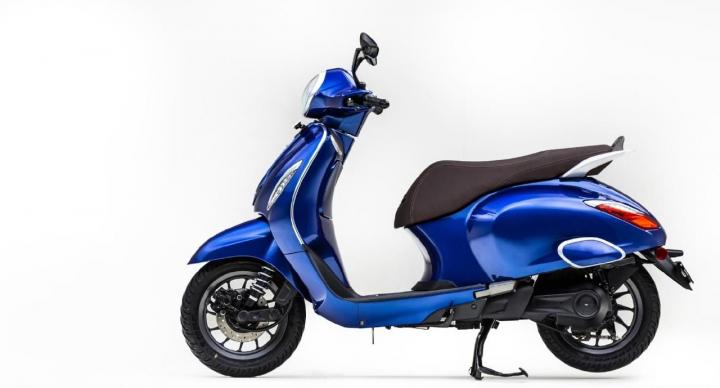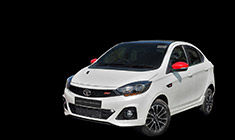News
My Pure EPluto 7G electric scooter: 8-month & 1300 km update
There are multiple issues with the electric vehicle. The only positive points are the powertrain & battery life.
BHPian Venky03 recently shared this with other enthusiasts.
My EPluto 7G has completed almost 8 months now, the running has primarily been in the city only.
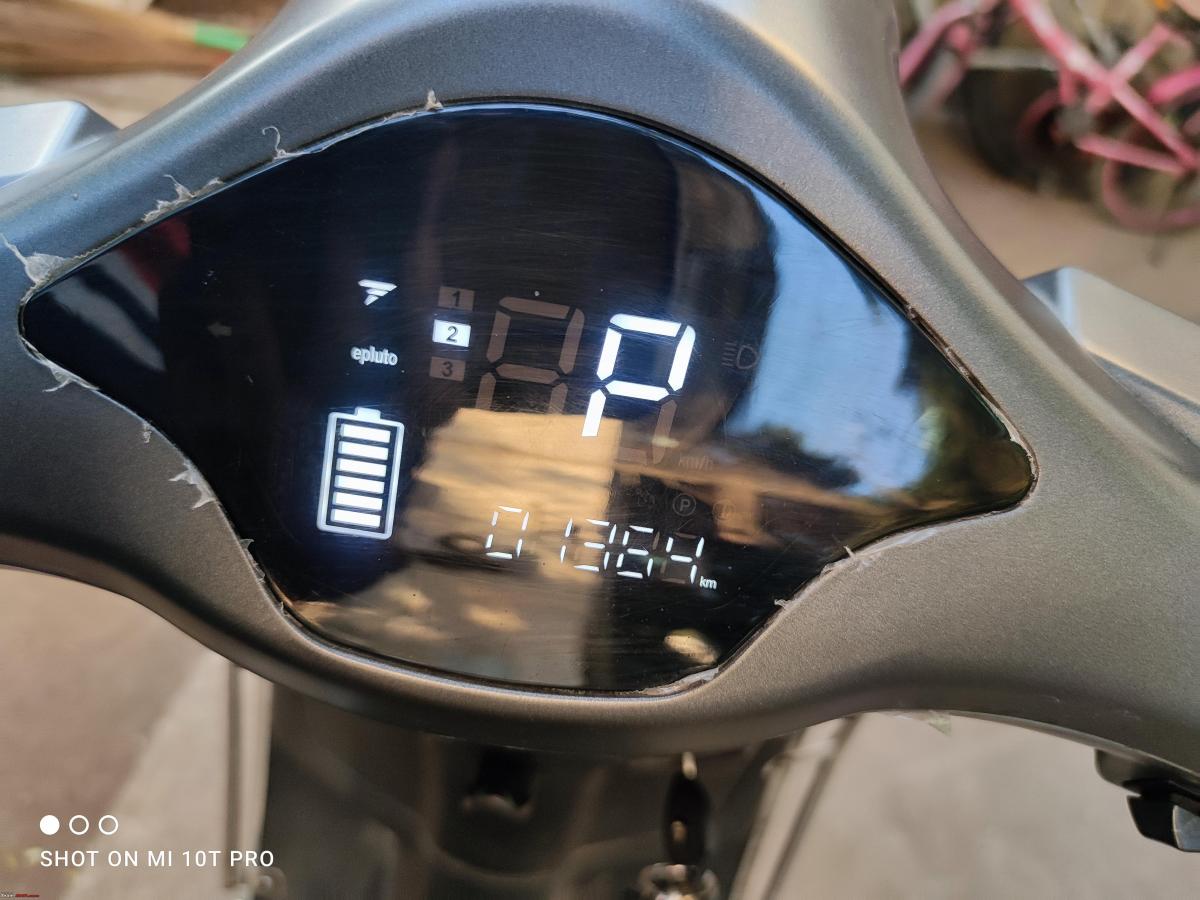
Positives
The powertrain and battery life is excellent, most of the time the scooter is used with 2 pax and still it is delivering 80-100kms per charge on mixed modes in the city. I'm very happy with the range and niggle-free powertrain, but sadly this is where the positives end.
Some main issues
Headlights - They're bright but unfortunately most of that light falls on the face of oncoming traffic even on the low beam. I'm sure the company is aware of this, it is a serious issue and there should be a voluntary recall to at least adjust the throw in a way that it doesn't blind the oncoming traffic.

Suspension - It's just present because they had to provide a suspension and that's about it. Don't know which vendor they're sourcing it from but it is not suited for Indian roads. They've updated the rear shock absorbers in the latest iteration of ETrance Neo, but will cost 2300 to upgrade. The rubber bushes in my rear shockers were already changed once, now they've started to squeak again.

Cosmetic condition - As I own a matte version, the paint is single stage. I was fine with it since I faced no issues with matte paint on my Jupiter. But the paint is too soft, it'll come off even if you use a good quality micro-fibre cloth. One of the users contacted the brand about it and got the reply that it can't be painted, instead change the entire panel; isn't this counterproductive?
Also the rust, it is present everywhere. Please note that the scooter was protected with the provided cover throughout the monsoons.





Product branding starting to fall off, also the company logo and every chromed surface on the scooter has also started to rust and I can't use a chrome polish on it without touching the paint.
Need to polish the chrome ring around the headlight and the chrome mirrors almost every week.

Very soft plastics used.

Now, this is my friend's EPluto which is just 2-3 months old and is the new model with increased boot space.

And he is facing the same major issues, so this means that the company has decided to not take any action regarding the initial feedback from early adopters.
When I confronted my dealer regarding this he asked to get the mirrors painted or replace them with a new pair.
Conclusion
I'm generally very optimistic with Indian startups as I'm myself a part of that ecosystem, but at earlier stages of a brand, it is very important to start acting up on the basis of customer feedback.
I've tried to contact them on the provided WhatsApp number about the same but no response even after a month. Now lodged a formal complaint last week from the form provided on their website, will keep this thread updated with how it goes.
Even after facing such issues, I would've happily dismissed them as gen 1 issues and invested in a gen 2 product from them; but it seems that they're not ready to acknowledge that the issues are present in the first place let alone fix them. I was completely aware that the EPluto is a gen 1 product and was ready to deal with the niggles, but ignorance and total lack of customer support from the brand is unacceptable.
I've had a very pleasant experience with both their dealers in Thane (Maitri Motors) and Borivali (RC Automobiles) but it always comes down to the brand at last.
I expected better from PURE, but it seems that they have different goals.
Check out BHPian comments for more insights and information.
- Tags:
- Indian
- EPluto 7G
- Electric Scooter
News
Petrol to electric scooters: When is the right time to switch
Scooters like the Yamaha Aerox & Aprilia SXR 160 are tempting options, but so is the Ather 450X.
BHPian KiloAlpha recently shared this with other enthusiasts.
Introduction
If you have a mainstream 110-125cc petrol-powered scooter (e.g. Honda Activa, Suzuki Access, TVS Jupiter, etc.), your scooter is just over 5 years old and the upgrade itch begins, should you buy another petrol scooter, or should you go electric to save your wallet and/or the planet? Maxi scooters like Yamaha Aerox and Aprilia SXR160 are tempting, as are stylish electric torque monsters like the Ather 450X. Or, maybe you could be totally sensible and buy another new mainstream 125cc scooter.
I am in the same situation. I have a 2014 TVS Wego in (touchwood) excellent condition. I got the upgrade itch. Then, I saw this video and I took a deep breath and started thinking about it from a fresh perspective.
Do you really need to scratch that upgrade itch at all? Alright, yes, granted that the running costs of an electric scooter are very low when compared to that of a petrol one. Yes, the torque can be addictive and exhilarating - correction, IT IS addictive and exhilarating. Setting aside the emotional arguments for an upgrade, are the numbers on your side? It has to make sense both from a financial and environmental standpoint, over the entire lifetime of the vehicle. If we can agree that exchanging your existing petrol scooter for a new one makes very little sense financially and no sense at all environmentally, the question we are addressing is whether one should buy a new electric scooter or just keep the old one.
*drumroll*
Enter the Excel Spreadsheet.
No, no, no, please, don't fall asleep yet. I promise this is going to get interesting.
Let's first get a few facts straight. From an environmental perspective, electric vehicles are not really 'zero emissions'. It takes a lot of resources (consequently emissions) to build a new vehicle. Lithium-Ion battery manufacturing is known to be a very polluting process and has a huge impact on the environment. Electricity generated from fossil fuels (e.g. coal) is also bad for the environment - the very same electricity used to charge the battery. Also, when you choose to buy a new thing, you are causing its manufacture and hence the resultant pollution. Continuing to use what you already have can sometimes be better for the environment.
The Numbers
Here are the basic facts on the basis of which I have done my analysis:
- 5 tons of CO2 is emitted just by manufacturing the electric scooter & battery. I am assuming the battery will not need to be replaced for the next 8 years.
- Electricity generation, transmission & distribution emits 1.2kg CO2 per kWh, assuming a coal-heavy fuel mix
- A petrol scooter emits 50g/km CO2. Oil extraction, refining, and distribution adds 125gm/km CO2 (@ 36km/l mileage), making total tailpipe emissions 175g/km
- An electric scooter has a typical range of 70km
- Electricity costs Rs 8.15/kWh (the highest domestic tariff in Bangalore), and petrol is Rs. 101/litre
- The maintenance cost for a petrol scooter will be Rs 4000/year, but only Rs 500/year for an electric scooter.
I have not taken insurance and tyres into account in my model, assuming that they will be the same for both overall so in a comparative study they will cancel out.
I used my own example and crunched the numbers. Turns out, it will be better for both my wallet and environment to just continue to use my Wego until it dies! The scooter is used 11km/day, mileage 36kmpl. My planning horizon is 8 years.
Lifetime CO2 emissions overall for petrol scooters is 5.6 tons, and for electric scooters it will be 6.6 tons. The total lifetime cost of ownership for petrol scooters, even accounting for increased maintenance as it ages, will be 1.22 lakhs, and for the electric scooters will be 1.6 lakhs.
So when does it make sense to buy an electric scooter?
Usage: If daily usage rises 14km, the lifetime emissions of petrol scooters and electric scooters become the same. Any more than 14 km/day of running, it makes environmental sense to buy an electric scooter. And at about 16.5 km per day of usage, the lifetime costs of petrol and electric scooters become equal, so anything more than daily usage of 17km, the electric scooter is better for both the environment and the wallet.
Bottom Line
If your 2-wheeler usage is low, around 10km/day, please keep your existing petrol scooter until it dies. Both the environment and your wallet will thank you. But if your usage is higher than 15 km/day, seriously consider switching to electric.
Disclaimer
I have got most of my numbers from searching the internet, and I am not sure of their accuracy. If anyone has more authentic data, please do plug it in the attached spreadsheet and share it with the community.
Here are my sources:
- Motorcycle Manufacturer Emissions: I used Yamaha Motor's sustainability report and their reported sales figures for 2020, and calculated per unit CO2 emissions
- Lithium-Ion Battery Manufacturer Emissions - Link
- Petrol Scooter Emissions: Honda Motorcycles UK website: I used figures published for the Vision 110 scooter and adjusted upwards by 15%
- Emissions from Power Generation - Link
- Supply Chain Emissions for Petrol - Link
Here's what BHPian sri_tesla had to say on the matter:
How did you come up with 5 tons of CO2 emissions for manufacturing an electric scooter? What about the manufacturing emissions for petrol scooters?
The major part that is the source of higher emissions in the manufacturing of electric scooters is the battery. Other than the battery the manufacturing emissions for both petrol and electric scooters should be the same. So, in the case of electric scooters, we need to calculate manufacturing emissions for battery production.
Based on the ICCT link you posted for battery production, the latest (2017) estimate which is already 4 years old has per kWh emissions at 56kgs. So, for a typical electric scooter with a 3 kWh battery, that is 168 kgs which are 0.168 metric tons. Even if we assume batteries are made using the Chinese grid which is coal-heavy, the 3 kWh battery production emissions will be 400 kgs (0.4 tons).
So, in comparison to petrol scooters, electric scooter manufacturing will produce 400 kgs of extra emissions. Manufacturing of remaining parts like tyres, lights, engines, motors, seats, plastics should produce the same amount of emissions.
When we buy new vehicles, we generally sell our old vehicles to someone else and they will continue to use them unless it's not working anymore. I agree that if your usage is low (10 to 15 km) and have a functional petrol scooter, you can continue to use it for another 1-2 years and change to an electric one as there will be more models available in the market at that time. If you are in the market for a new scooter, then it's better to go with an electric scooter even if it's slightly costlier than a petrol scooter as you will quickly recover the extra costs despite low usage due to higher fuel costs.
Here's what BHPian Electromotive had to say on the matter:
No offence to OP, but how many of us consider the environmental impact when purchasing a vehicle or any other product? I want a poll to see what the data looks like and how high is environmental consideration in the list of priorities when purchasing a vehicle.
I know a few people who have moved to BEVs and do you know how many made the change because they wanted to reduce their ecological impact? ZERO. That's right - Zero. People are buying BEVs because they are the new trendy thing, good looking, cheaper to run and maintain and hella-fun to drive. Eco-friendly is just something to feel good and brag about but never the primary consideration when making the switch to BEVs.
Check out BHPian comments for more insights and information.
- Tags:
- Indian
- Electric Scooter
- Scooter
News
Ownership review: 2000 kms with my Ather 450X e-scooter
Fit and finish no where near to what it was during launch. Quality has gone downhill.
BHPian nkrishnap recently shared this with other enthusiasts.
An Ather 450X comes home in Space Grey Matte colour:

Positives:
- Nimble Handling.
- Strong Brakes.
- Comfortable riding position.
- Proven until now with no major mechanical issues (though some issues have been documented, none that will knock the scooter off the list).
- Nice lovely matte finish paint.
- Decent Range (would have loved 50% more).
- Strong acceleration in Sports and Warp mode.
Negatives:
- Fit and finish no where near to what it was during launch. Quality has gone downhill.
- Dealership experience, horrendous at best.
- Lack of color options (would have preferred the range like OLA is offering).
- Rough edges around panels, again downward trend from Ather.
- Lack of faster charging (though the Ather grid is there, would have preferred a faster charging).
- Mirrors are of little use, size and position not suitable for all riders with varying heights (again the quality of mirror mounts is below average, it was better when it was launched).
- No parking brake or hold, that you get in the regular scooters like Ntorq, Jupiter, etc. comes very handy at the signals and parking where the road has incline or slope.
Prologue:
The rising fuel costs were becoming a worry especially on the NTorq as the running also increased and the mileage isn't great either. I was contemplating on an electric scooter early April 2021, however lockdown was imposed for the 2nd wave of Covid-19 Virus. This meant only one thing, all plans on vehicles put on hold.
I had a fall at workplace and ACL tear was the end result. I underwent the ACL reconstruction surgery on the 28th of July 2021 and the rehab followed. Post 60 days of the surgery, the knee seems to holding up and the green signal from the doctor to ride the scooter was a blessing. Now the discussion of picking up an electric started all over again. More on why the Ather 450X in the subsequent posts
Customary Delivery Picture:
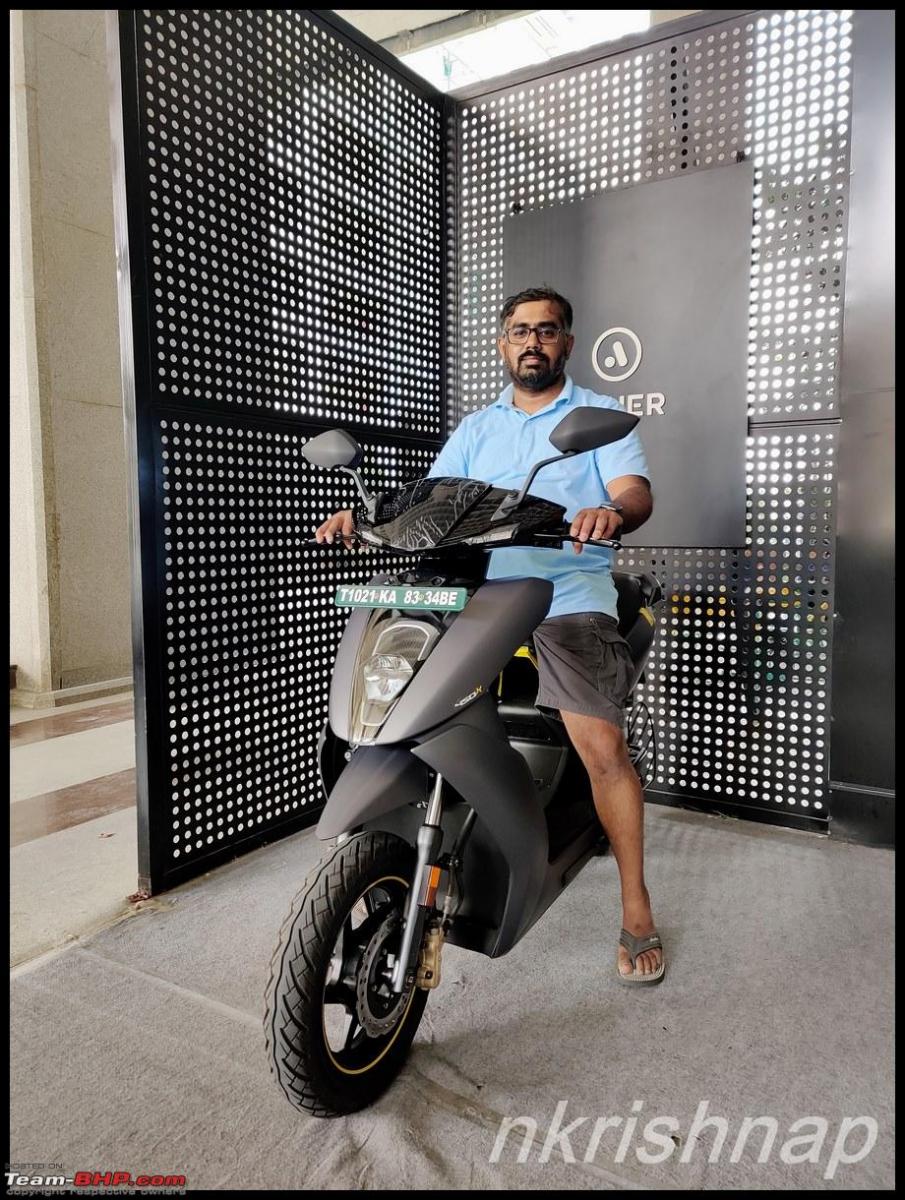
Technical Specifications:
Model: Ather 450X.
Peak power: 6 kWh.
Max torque: 26 Nm.
Top speed: 80 kmph.
Ride mode and range:
- Eco - 85 kms.
- Ride - 70 kms.
- Sport - 60 kms.
- Warp - 50 kms.
Range with standard test condition (Indian Drive Cycle as they call it) is claimed to be 116 kms. This is more for academic purpose than anything else as not many would be willing to ride the scooter to get 116 kms in a charge all the time.
Charger type: Ather Dot or portable charger.
Battery type & capacity: Lithium Ion with 2.9 kWh.
Transmission type: Belt drive.
Rim size: Front 12 inch with 2.15 inches width and Rear 12 inch with 2.5" width. Both front and rear rim width should have been the same, though this a minor difference.
Tyre size: 90/90 R12 tubeless for both front and rear.
Front brakes: 200 mm dia with combined braking system, hydraulically actuated triple piston caliper.
Rear brakes: 190 mm dia with hydraulically actuated with single piston caliper.
Front suspension: Telescopic forks.
Rear suspension: Mono shocks.
Lights: Ather has all LED lights for Headlight, Tail Lights, indicators, position lamps.
Weight: 108 kgs.
Boot capacity: 22 Litres.
Connectivity: 4G LTE.
Bluetooth: Bluetooth 4.2.
Additional features:
- OTA updates.
- Navigation with display on the dashboard.
- Side stand sensor.
- Auto indicator off.
- Guide me home lights.
- Mobile app connectivity.
- Ride Stats, Push Navigation, Live Location, Vehicle state tracking, Music & Call Control via the app.
With the knee getting better and the doctor approving me to ride the scooter again, the odo started climbing up pretty quick. The rising petrol prices did not help one bit and it started pinching the pocket big time. Then came the thought of buying an EV to cut costs and ended up with question of which one to buy. The cheap Chinese bolt on ones were ruled out instantly. Never been a fan of Bajaj vehicles, so the Chetak was not even considered. This left me with either the Ather 450X or the TVS iCube.
Observations on the TVS iCube:
During one of the visits to Bharath TVS for picking up spares for NTorq and my RTR, too the iCube for a quick spin. iCube looks more like a dressed up Jupiter. Feels similar to ride to the Jupiter. It is very quiet. It has economy and sport mode (if I recall correctly). The range in Eco mode is claimed at 75 kms and Sport with 50 kms. The acceleration is decent enough for the city and the range I am certainly not sure as to what expect in the long run. Rough on road cost is around 1.24 lakhs including charger. The cost is in favour of the TVS but the longevity, battery performance and motor durability is still unknown. So the iCube is on hold.
Observations on the Ather 450X:
I had a chance to ride our Teambhpian's Hemanth's Ather few months back. It feels just like the scooter fell into place and felt this is it. Then another friend pick up the Ather 450X rode it again for a considerable distance. Felt apt vehicle to pick up. However, the cost was a concern. Started debating on if it is Ather 450X or iCube. After a couple of days Ather 450X came out as the winner.
Ended up buying the scooter under the company name, as you can claim the FAME subsidy only once per Aadhar card if you buy it in individual's name. There is no such restrictions in case you buy it in a company name.
How much does the Ather 450X cost:
Due to the FAME II subsidy, the pricing seems very weird with something added and deleted to compute a number. Ather could have kept this simple.
Cost break up:
Rate: INR 160,942/-
GST @5% - INR 8,047.10/-
Total - INR 168,989.10
Fame II Subsidy - INR 43,500/-
Ex showroom price - INR 125,489.10/-
450X Performance Upgrade Cost - INR 16,110/-
GST @ 18% - INR 2,899.80/-
Total - INR 19,009.80/-
Cost excluding registration and insurance - INR 144,489.90 /-
Insurance with all add ons of nil depreciation and Return to Invoice costs INR 5,706.07/-. The insurance is provided by Go Digit General Insurance Limited.
I believe registration charges were INR 700/-.
If you need an extra charger (I opted for an additional one, One will be at home and one at work place) which costed me INR 10,950/-.
Ather Connect Pro and Service Pro costed me 2,400 and 3,600 exclusive of GST.
The whole scooter is sleek and narrow and the design theme is in sync from the front to the rear.
Front:
Front has a V shape theme with the fairing, headlights, mud guard and the piano black plastic trims. the low beam and high beams are stacked one over the other. The indicators are housed in the top console along with the DRL. DRL and indictors are pretty bright. You cannot miss them even in broad day light.
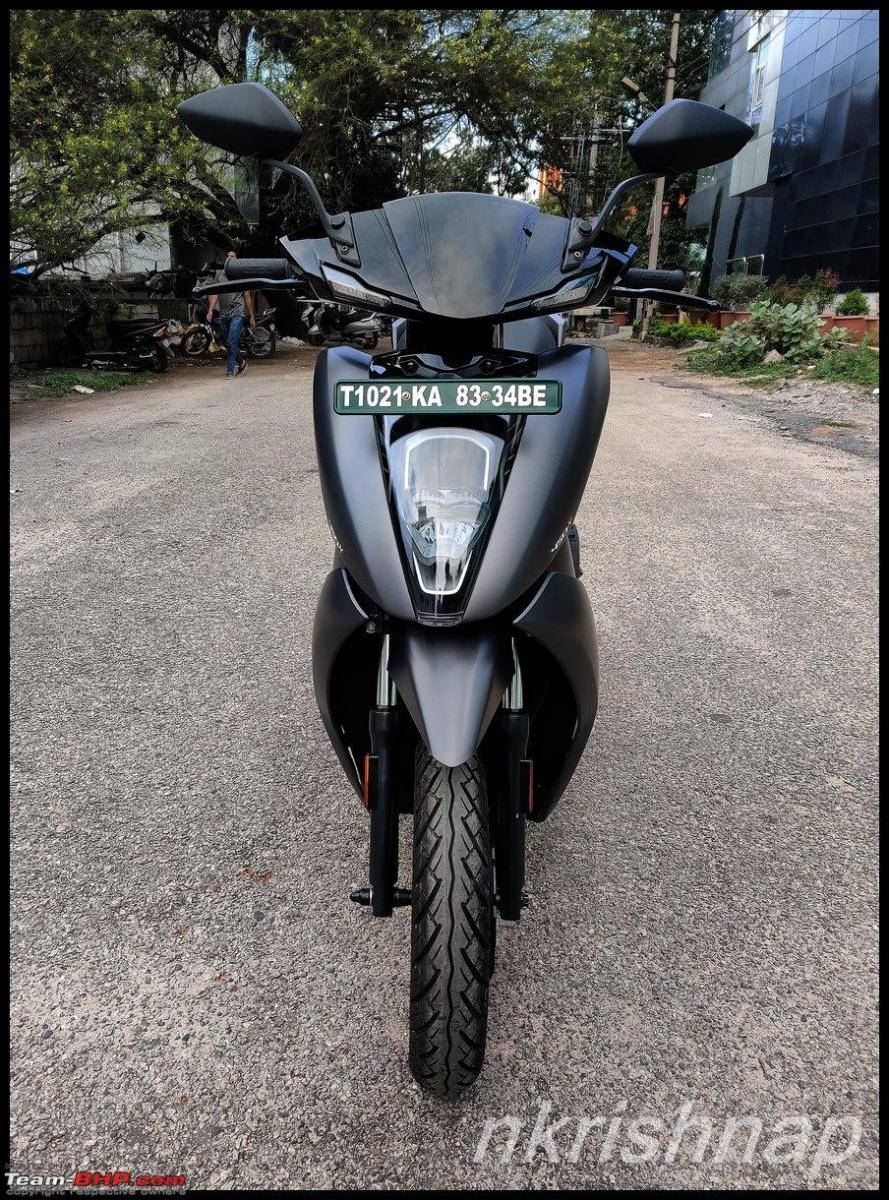
Front three quarter:
The sleek design pattern continues on the sides too:
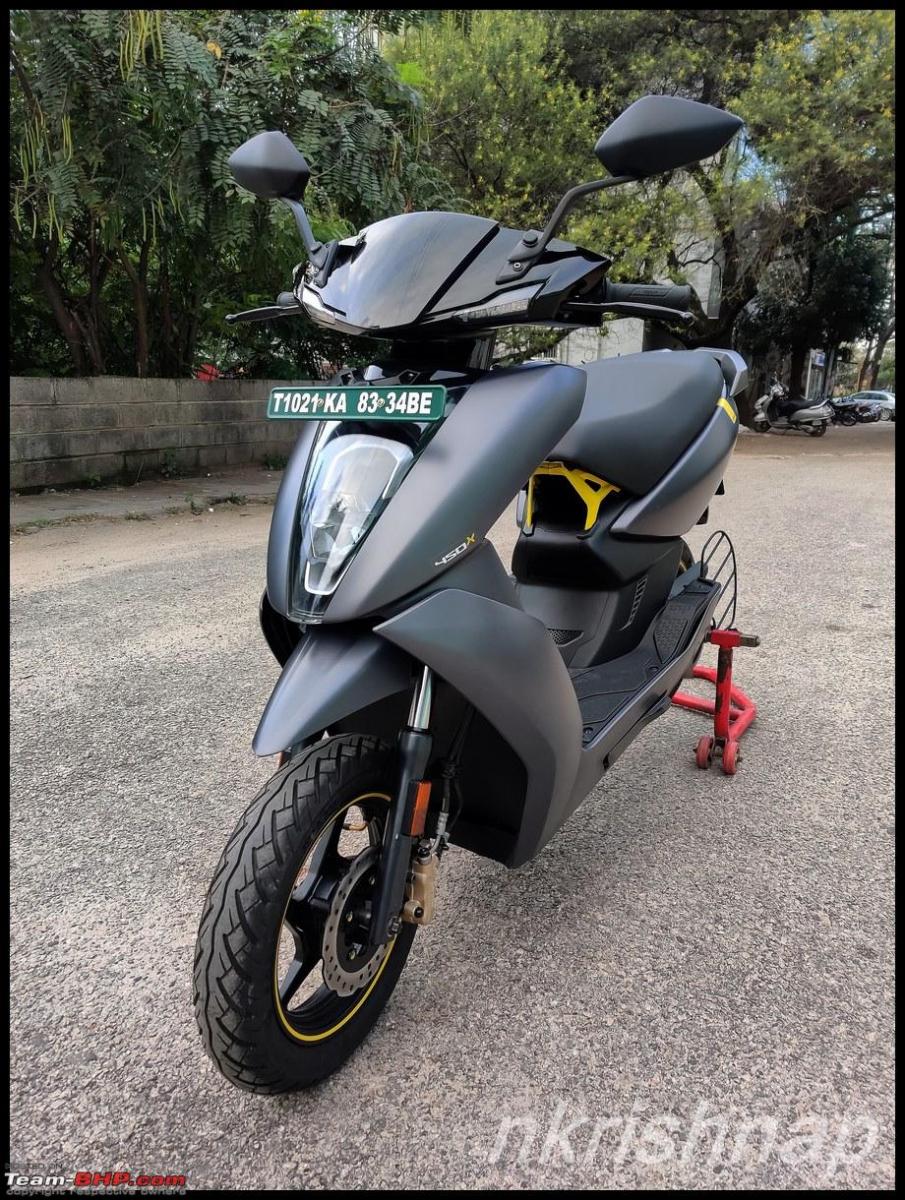
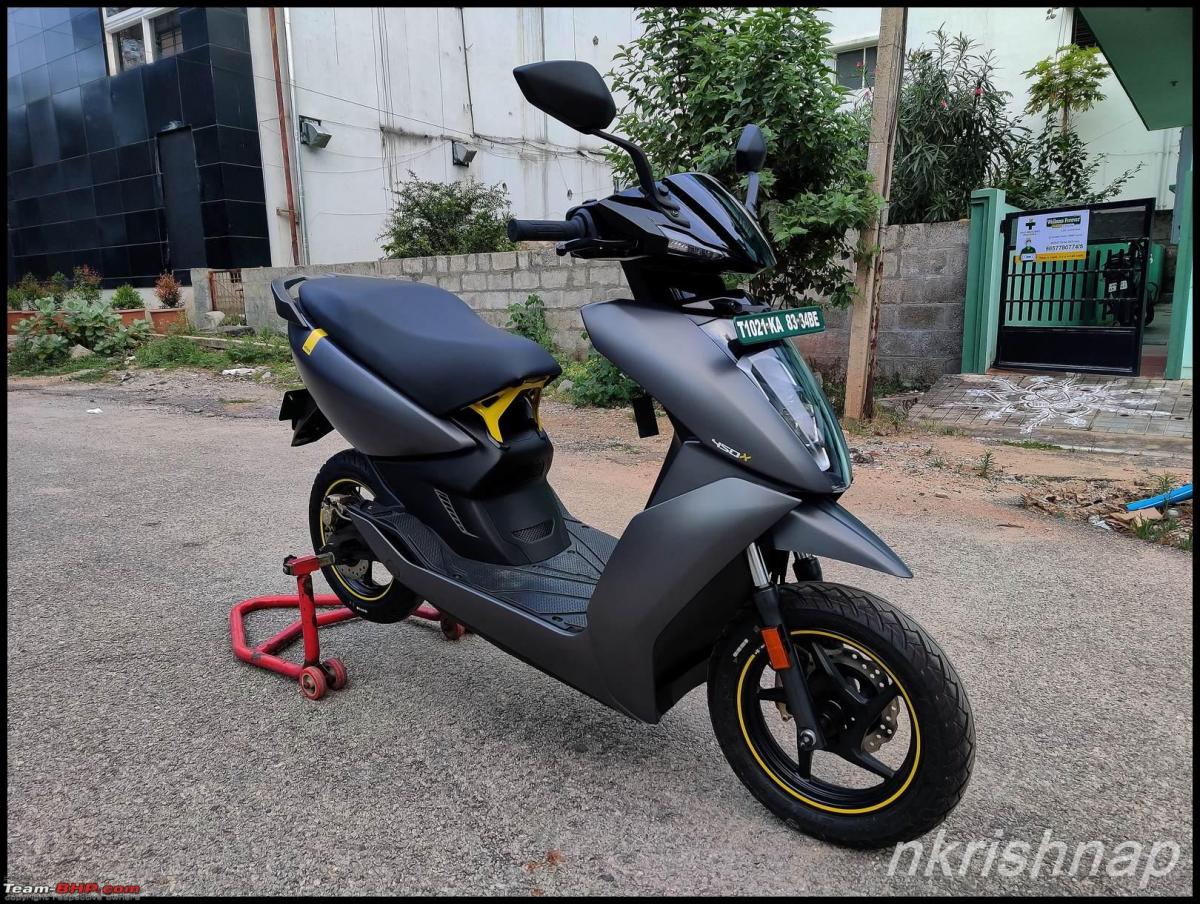
Side:
Notice the subtle yellow color for the frame, rear suspension, a sticker on the panels and pin stripes on the wheels which go well with the matte finish grey.

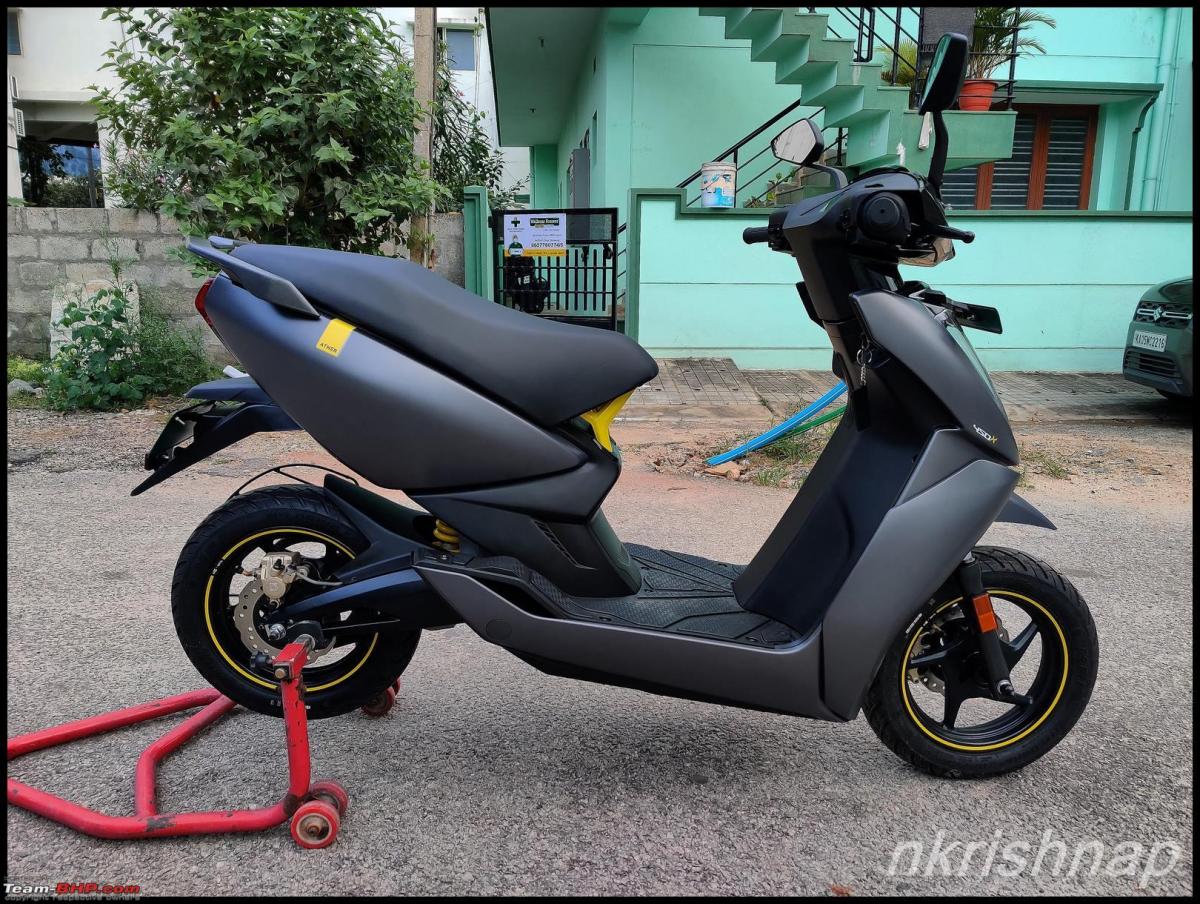
Rear three quarter:
The rear three quarter is more subdued compared to the front. The saree guard is an eye sore. wondering should I just remove it.
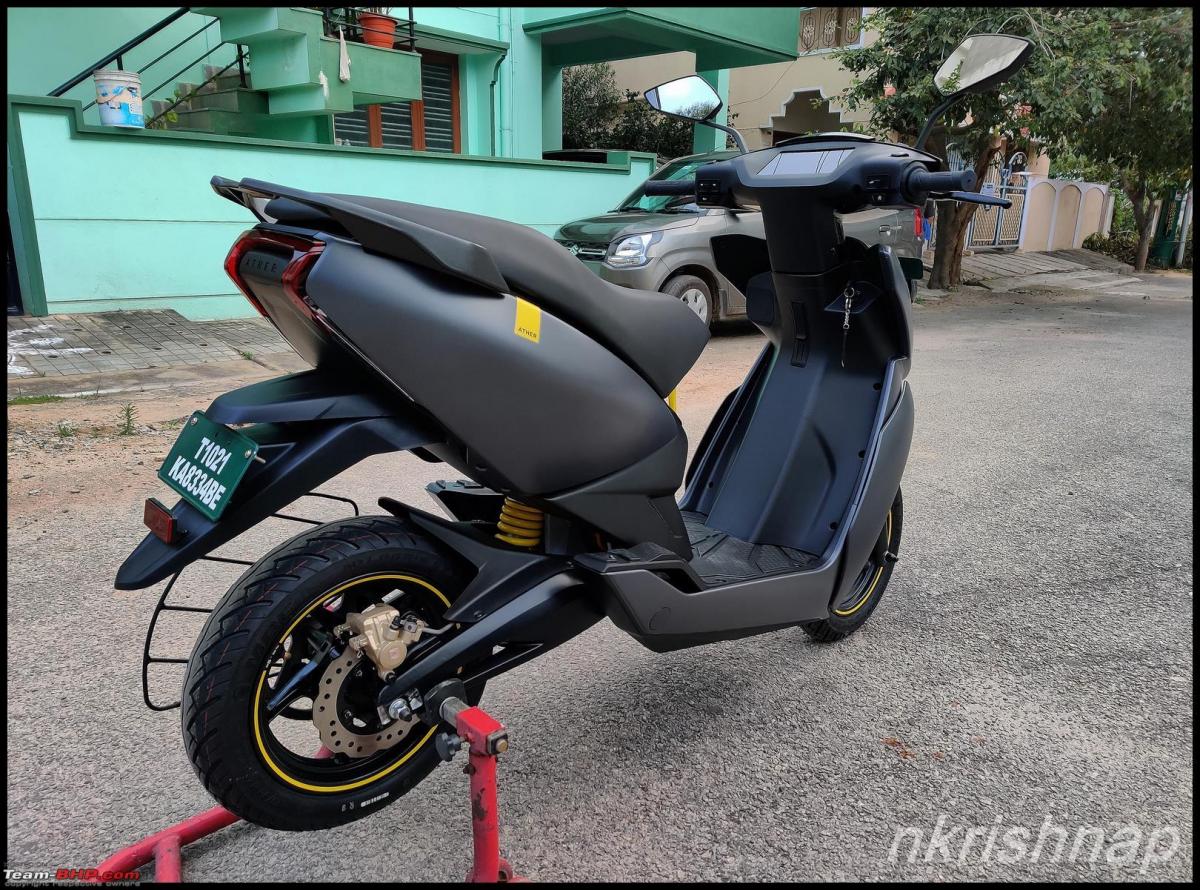
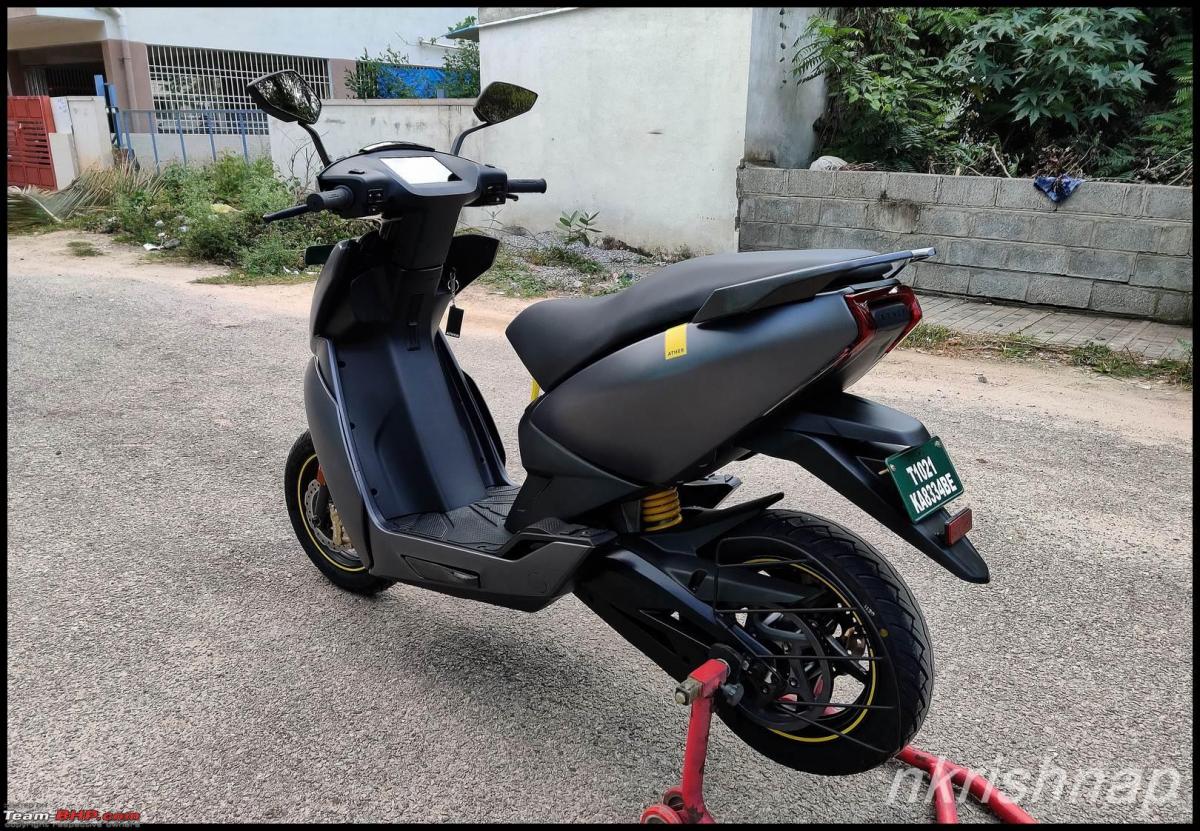
Rear:
The tail lamp, brake lights, rear indicators are all LED housed in an inverted U shape:
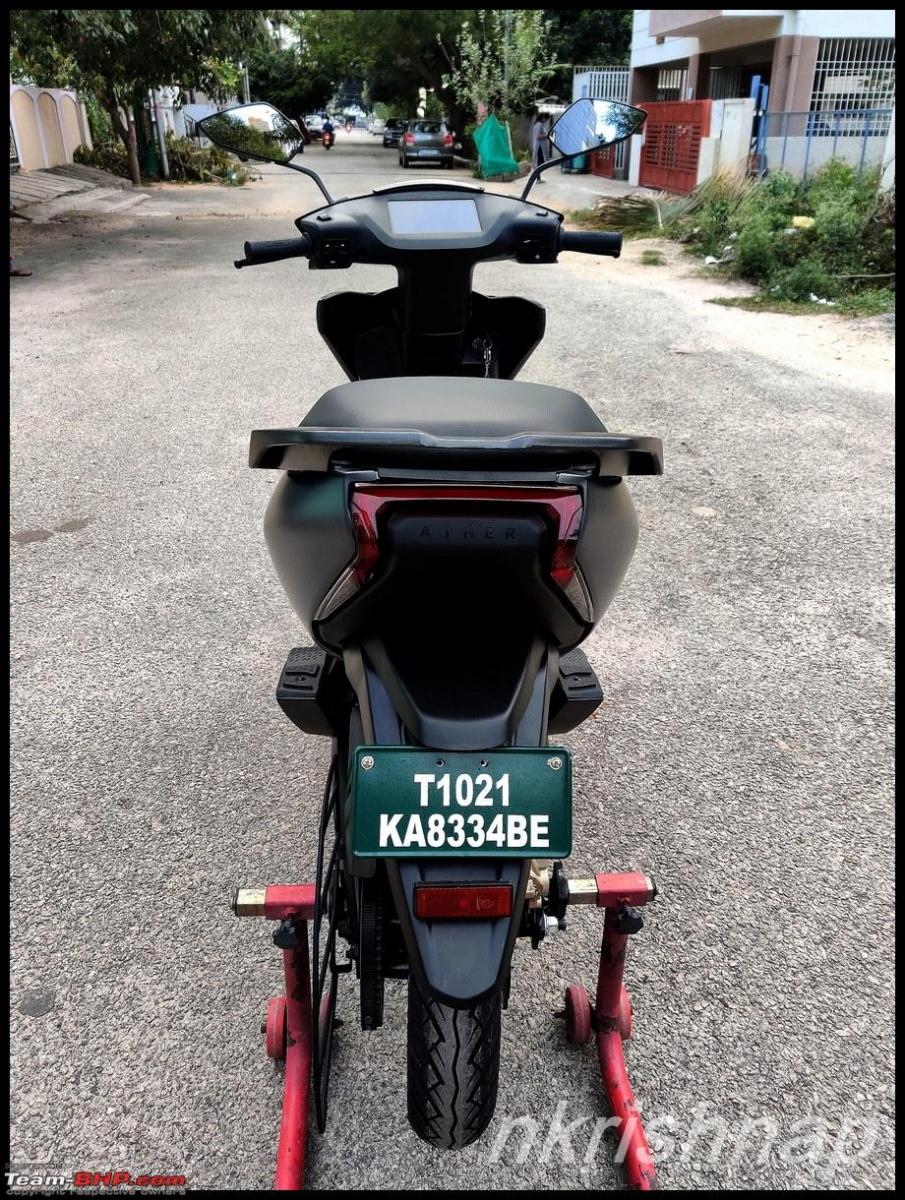
Switch gear area:
Quality of the switches are nothing to write home about:
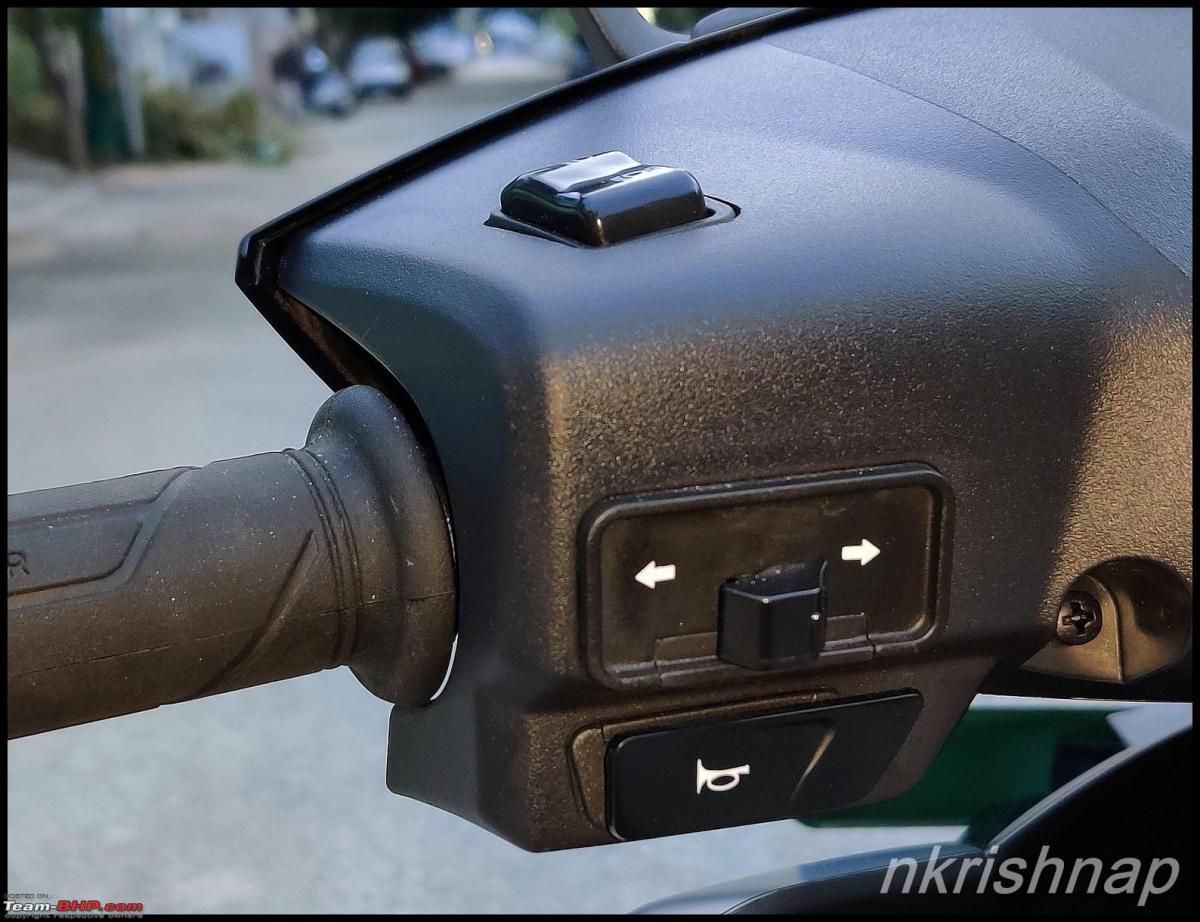
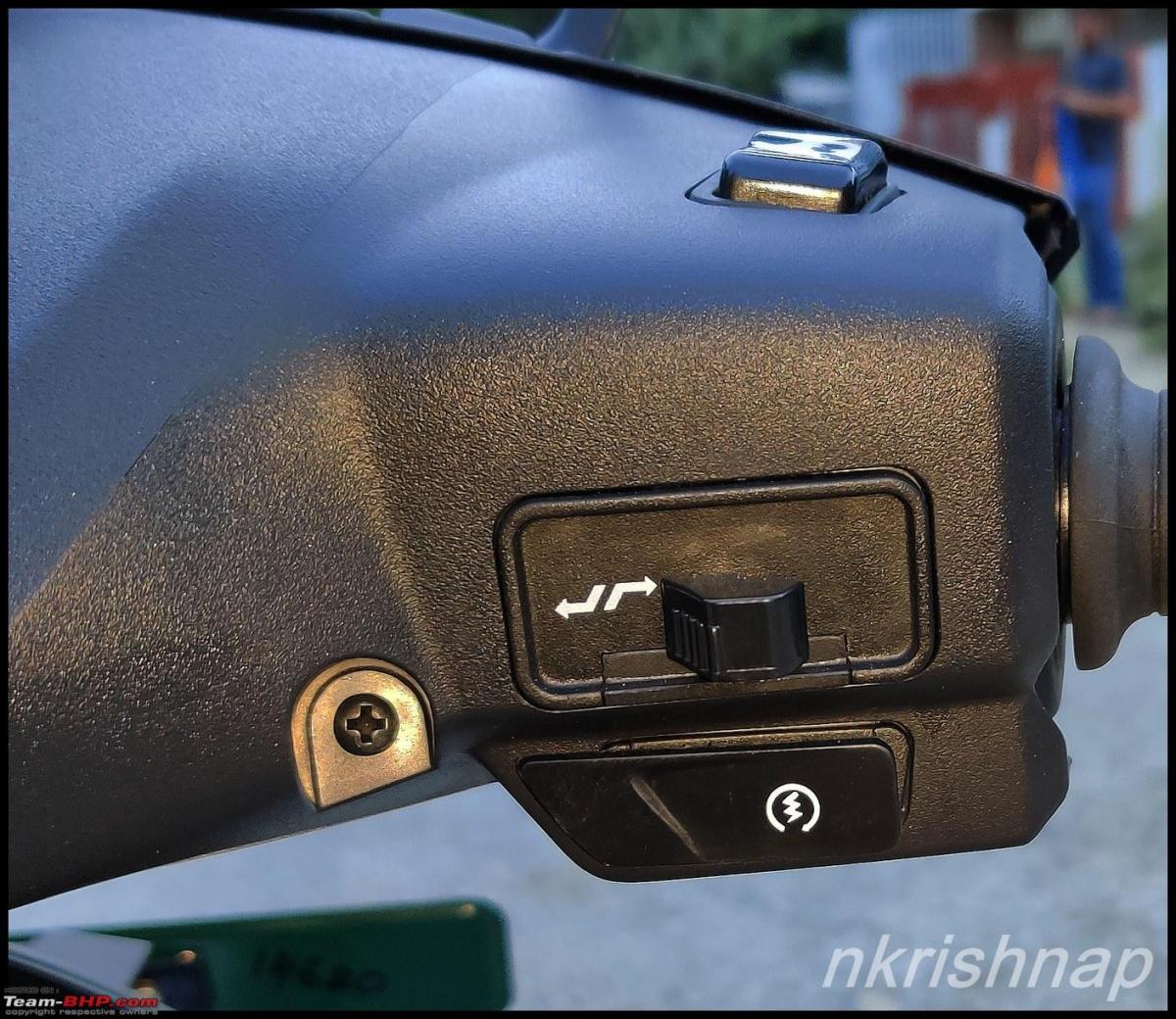
Centte console and storeage:
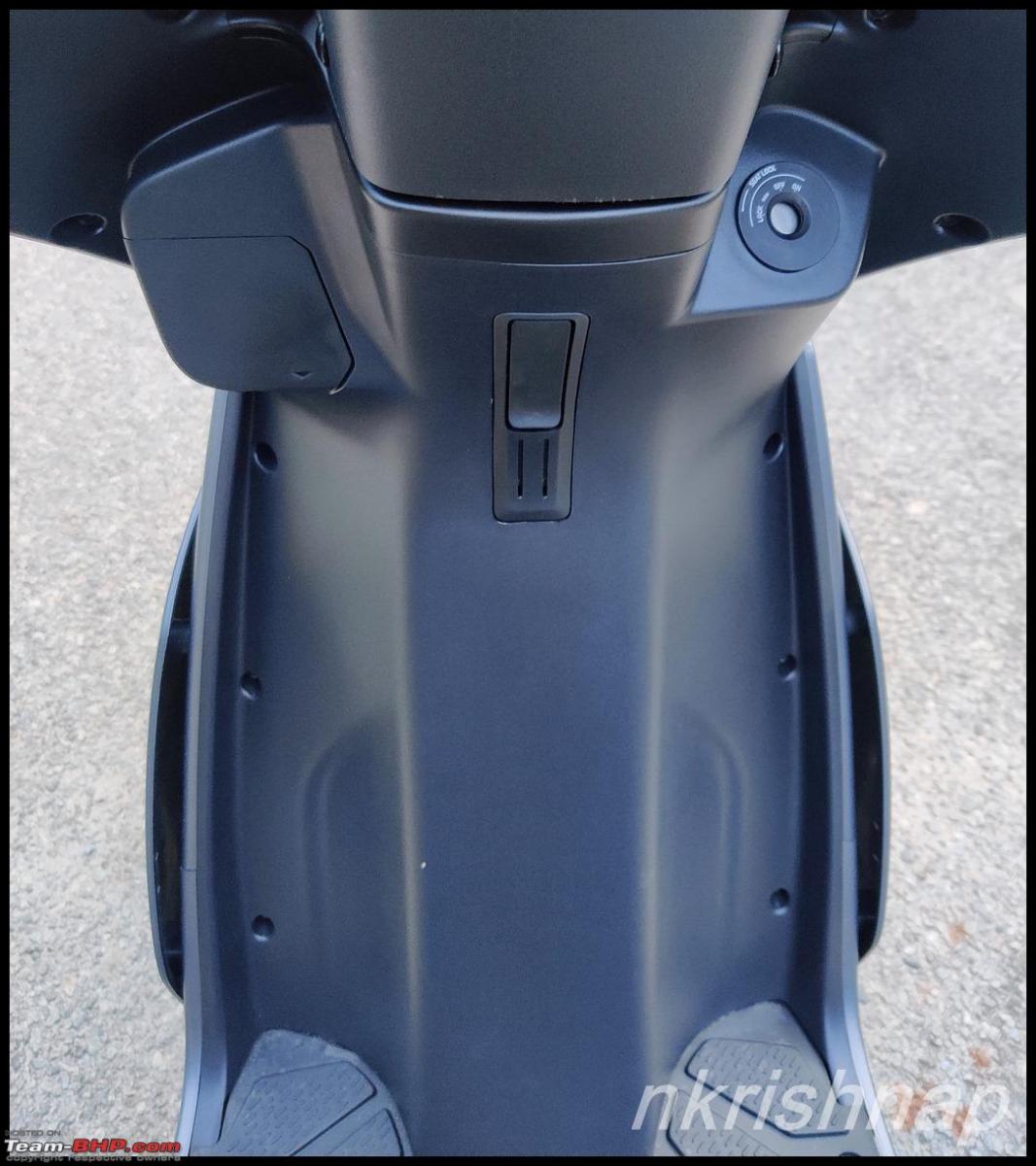
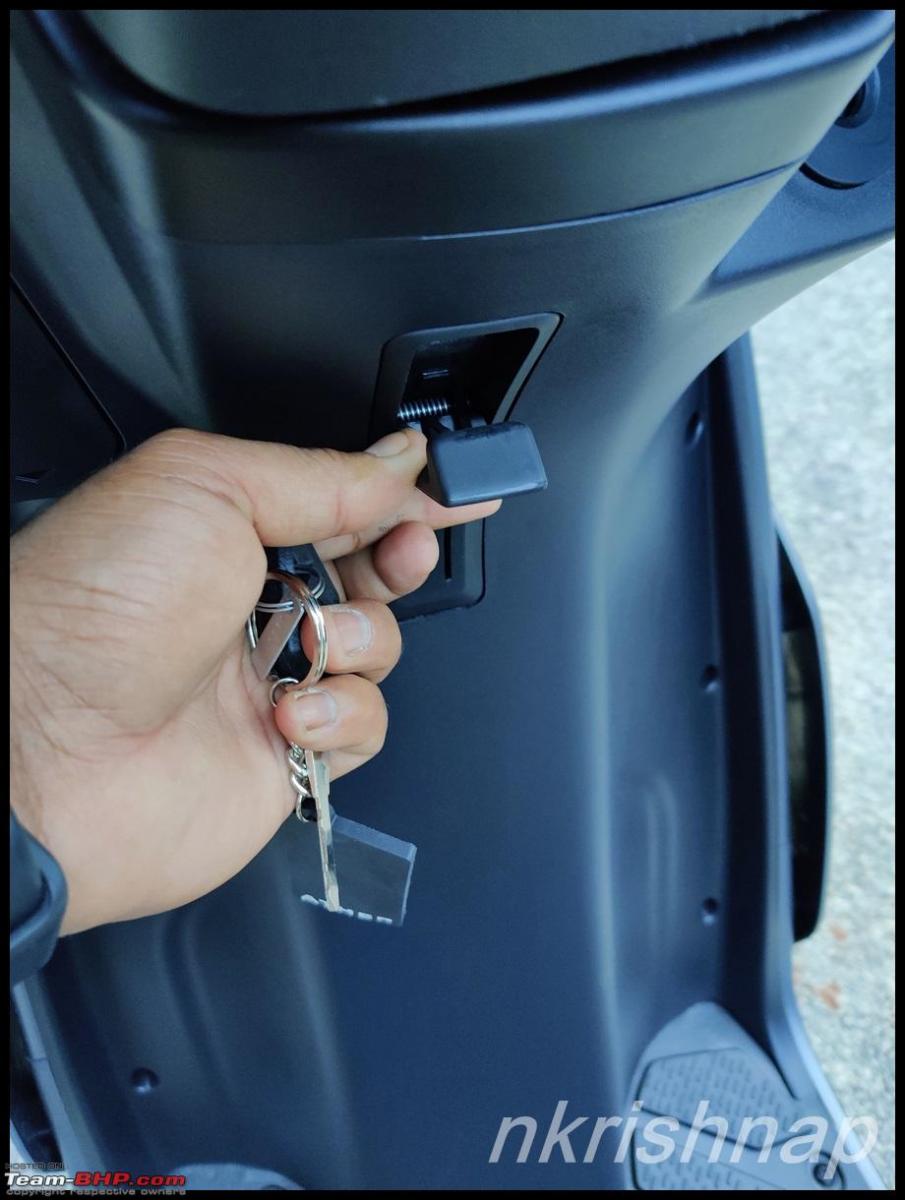
Front discs and telescopic folks:
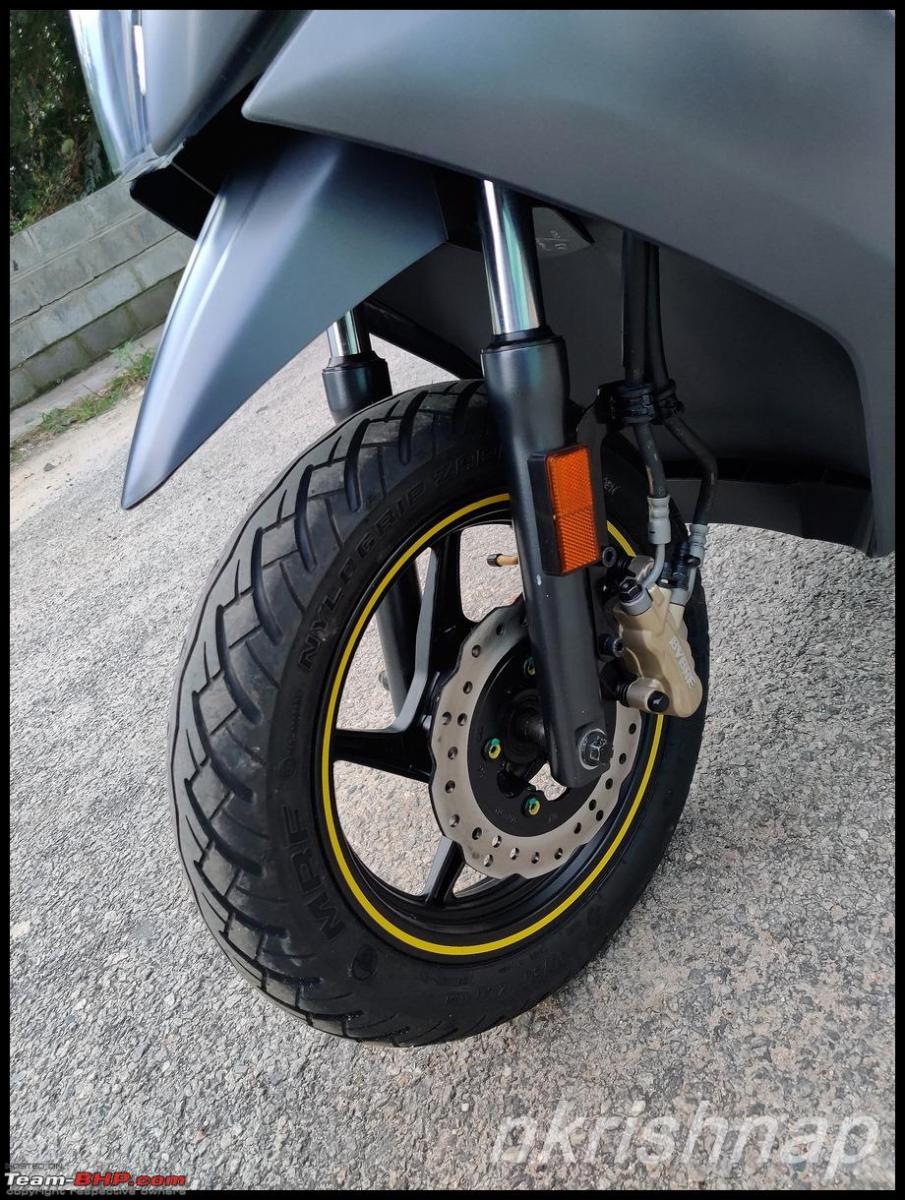
Key slot:
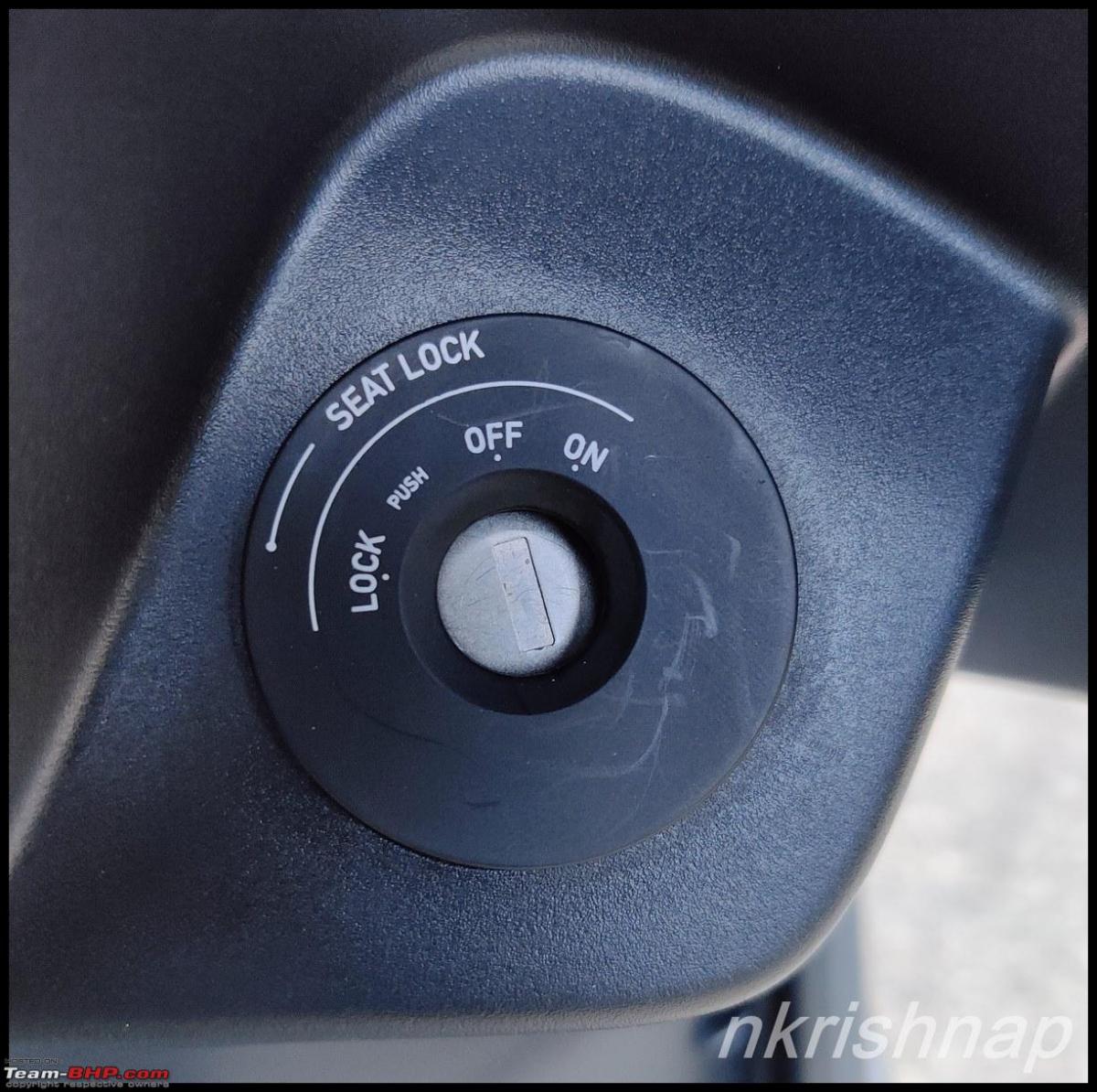
Belt drive:
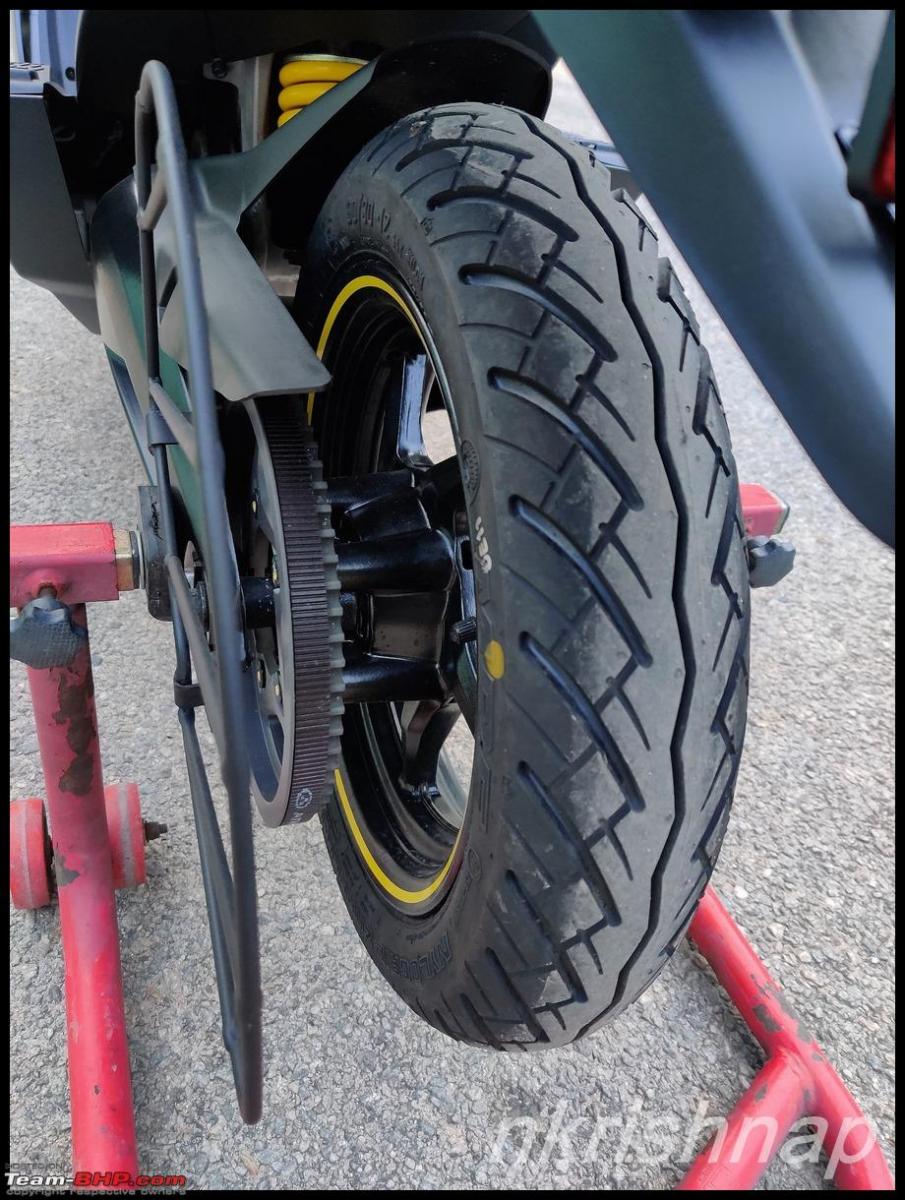
Continue reading BHPian nkrishnap's review of his Ather 450X e-scooter for BHPian comments, insights and information.
News
Upcoming Okinawa electric scooter spied
Unlike the sleek and compact Ather 450X and the Ola S1 Pro, the Oki90 looks rather large.
Looks like Okinawa is working on a new electric scooter for the Indian market. The new model, believed to be the Oki90, was recently spied testing.
Okinawa's upcoming e-scooter caught our attention because of its sheer size. Unlike the sleek and compact Ather 450X and the Ola S1 Pro, this e-scooter looks rather large.
In terms of features, the Oki90 comes with an LED headlamp and a digital instrument cluster with Bluetooth connectivity. It is likely to get two riding modes - Eco and Power.
The new e-scooter appears to have a long wheelbase and is equipped with large alloy wheels. It has telescopic suspension at the front and twin shock absorbers at the rear. It also gets disc brakes at both ends.
Source: 91wheels
News
My TVS iQube electric scooter: 9-month ownership experience
I'd say that the ride quality of the iQube is on par with that of the TVS Jupiter & Honda Activa. In fact, perhaps, it's slightly better thanks to the silent ride & absence of vibrations.
BHPian prasi55 recently shared this with other enthusiasts.
It's been 9 months since I purchased the TVS iQube electric scooter. I wanted to share my ownership report.
Positives
- Comfortable riding position
- Good suspension
- Good pillion ride experience
- Decent-sized mirrors
- Good sales and service experience
- Wide footboard
- Enough storage space
- Proven until now with no major issues
- Decent range
- Normal mode is more than adequate for city riding
- 12-inch front and rear tires (with a caveat)
Negatives
- Range could have been more (at least 40% more)
- Color options would have been nice
- No fast charging
- Quality is par for the course but could have been better
Background
I moved back to Bangalore in late 2013 and quickly realized the need for a scooter to manage short runs for groceries or other stuff. While exploring options, I came upon electric scooters from Yo Bikes and Ampere. Both options involved lead-acid batteries. Given my cycling and triathlon background, I decided to explore green electric scooters. Yo was quickly rejected due to poor sales experience. Ampere v60 seemed promising (range of 75 in eco mode and 55 in normal mode) mainly due to a knowledgeable dealer near my place, and I finalized it for about INR 55000 on-road in early 2014.
Soon after, in early 2015, I continued my electric journey with the Mahindra E2O.
The Ampere had a top speed of 40kmph - allowing folks without a license to use it, and served me well. I changed the battery once (damages INR 15000). After 7 years, the replacement battery went for a toss, and the 7-year itch for a new bike started.
This time, a few options with Li-ion batteries were available, and I decided to focus on the most popular ones: Bajaj Chetak, Ather 450+, and TVS iQube.
The Chetak impressed with its retro looks. But despite it being available in the KTM showroom near my place, they refused to offer a test ride. I booked the test ride online but did not get a response. Meanwhile, I also read reports about the deliveries being delayed and a price increase. Decided to move on and focus on the Ather and iQube.
I visited the Ather experience center in Indiranagar. It was pretty impressive. The Ather is one scooter with impressive build quality. The test ride proved this. The seating position was good - it felt like sitting on a bike or at least a maxiscooter. Overall, it felt very well put together. However, I was keen to test out the pillion ride experience, so asked my friend to ride. The same suspension that felt stiff yet perfect for the rider felt bouncy for the pillion. I couldn't find a good seating position and was overall quite uncomfortable.
Even so, I enquired about the pricing. This was March 2021, about a month before additional FAME subsidies rolled out. I was quoted about INR 150000 for the Ather 450+ and about INR 170000 for the Ather 450X. I was interested in the Ather 450+ despite the pricing being higher than budget, but some things put me off:
- The Ather Connect Pro and Service Pro annual cost of 2,400 and 3,600 exclusive of GST
- The additional cost of about 10K for a portable charger
- The poor pillion ride experience
This meant that I would be paying north of INR 165000 on road and yet not have a comfortable ride experience for 2 people, my primary use case.
So I looked at the TVS iQube. The showroom was just 2 km from my place, and the experience was quite positive. I was given multiple test drives. The silent ride, plush suspension, wide footboard, comfortable ride experience for 1 or 2 people, and decent quality of components won me over. Given this was before the additional FAME subsidy, the pricing was INR 115000 plus INR 8250 for the charger. Given the comparable ICE Jupiter costs north of INR 100000 on road, this was a no brainer and I placed an order. I got the delivery in about 3 weeks.
Delivery picture
TVS iQube - what has it got?
Techincal specs:
- Model: TVS iQube
- Peak Power - 4.4 kWh
- Weight - 118 kg
- Top Speed - 78 kmph
- Tyre Size - Front and rear both 90/90-12, Tubeless
- Brakes - Front disc, rear drum
- Suspension - Front telescopic, rear Hydraulic twin-tube shock absorber
- Peak (wheel) torque - 140 Nm
- Charger Type - TVS SmartXHome Charger or Portable Charger
- Battery Type & Capacity - Lithium-Ion with 2.5 kWh
- Battery Warranty - 3 years or 50000 km, whichever is earlier
- Transmission Type - Hub drive
- Lights - LED lights for Headlight, Tail Lights, indicators, position lamps.
- Boot Capacity - ~20 Litres
- USB Charging port - Yes (with light)
- Connectivity - 4G LTE
- Bluetooth - Yes
Ride modes and range:
- Normal - 75 km
- Sport - 50 km
Why TVS iQube?
I wanted my scooter ownership experience to be as hassle-free as possible. This meant easy access to a service center. A few friends own TVS scooters/bikes and they mentioned how prompt the sales/service teams were in ensuring good service.
I was lucky to have a good ownership experience with the Ampere v60 because I was less than 4 km away from my dealer, who was quite knowledgeable and prompt with service. However, on a couple of occasions when I had to get replacement parts, the process took close to a month on at least two occasions because the older parts had to be shipped to Tamil Nadu, their status verified and approved, and only then would the replacement parts be shipped back, and so on. This is why I chose not to consider other options such as ePluto 7g or the Okinawa series.
I also liked the comfortable riding position and plush suspension. It's a breeze to ride in traffic. Rides with 2 people on board are a breeze - literally, too, as the breeze is the only thing you'll feel given how silent it is. I take care to honk as needed so that people are not caught unawares.
Having owned the scooter for close to 9 months, I must say am very pleased with the scooter. The range has been 75 km as advertised (maybe because of my relatively light build) and I take care not to do sudden acceleration or braking, factors that can reduce the range.
I got the first service done at about 7-8 months. Recommended is every 4 months or 4000 km. The service experience was excellent and cost about INR 700.
I had an accident a couple of weeks ago when I lost balance due to the back road near my apartment being dug up and shoddily patched. I took the scooter to the service center. 3-4 body parts needed to be replaced, new stoppers needed to be installed as the handle/lock had got misaligned, and the brakes had to be tightened. I thought about claiming insurance but for some reason decided they were minor repairs and decided not to. Again the service experience was excellent. 3 new body panels, new stopper, brake tightening, along with labor cost less than INR 2500.
If there's one thing I am not very happy about, it's the tires. Somehow I feel they are of low quality (even though MRF) and don't provide enough grip. I've read that the sudden torque might cause early wear and tear of the tires, and I've been guilty of not maintaining adequate tire pressure at times (the negatives of not having to visit petrol pumps), but I still feel TVS should have provided tires with better grip.
How much did the TVS iQube cost
I booked the TVS iQube about 1 week before they increased the pricing by INR 5000, and 2 weeks before it was given additional FAME II subsidy of ~INR 14000.
I ended up paying INR 115000 including registration and insurance, and an additional INR 8250 for the portable charger. I also installed a sidestep footrest for about INR 700.
How does TVS iQube look
The scooter bears a minimalistic look. Its dimensions remind one of the ICE Jupiter, but the DRL patterns make it stand out.
Front
The front has a U-shaped theme. The low beam and high beams are stacked. The indicators are housed in the console along with the DRL. DRL and indictors are reasonably bright.
Side profile
The side profile is elegant. The lit ELECTRIC sign near the rear suspension adds a nice touch.
(Image from the web)
Will add more pictures later.
How it rides
I have completed almost 2,000 kms as of date. During this period, the following are my observations on the motor, ride and handling, and brakes.
Motor
The motor comes with a peak power of 4.5 kW. Since it is a hub-mounted motor, the torque is calculated differently from drive-mounted motors such as Ather's.
When you turn on the ignition:
- The headlights turn on.
- The dashboard turns on with the logo of TVS accompanied by music around 10-12 seconds from the key is turned on. At this time, you can press the brake and the riding mode to start the scooter (while the music continues).
To ride the scooter, depress the brake and press the mode switch. Then turn the throttle to accelerate. Turn the throttle in the opposite direction to apply regenerative braking.
To switch between normal and power modes, depress the brakes and press the ride mode button.
There's also a reverse park assist mode that allows you to creep forward/reverse at about 5 kmph.
Normal mode
The Normal mode restricts the speeds to around 45-48 kmph (was able to hit 45 kmph) but is more than adequate in city traffic. It has enough torque to pull on straight roads or inclines with two onboard. Ridden with a light foot, the normal mode gives me a range of 70-80 km and should give a regular rider around 70 km of real-world range.
Power mode
The Power mode provides quick acceleration and increased torque. Unlike ICE scooters, in EVs, the torque is available from the word go, so you'll find yourself overtaking other scooters in no time. Coupled with the silent ride, the ride feels like a knife running through butter.
Ride & handling
The TVS iQube handles reasonably well. The suspension is plush and comfortable. However, this and the somewhat skewed placement of the 3 battery packs means that leaning around curves doesn't feel as taut as balanced. Low-speed ride is pretty good. As I mentioned, the brakes could be a little better and the tires could do with a lot more grip.
I would put the ride quality on par with the Jupiter and Activa, maybe slightly better due to the silent ride and absence of vibrations.
Brakes
The brakes are acceptable but could be better. Given the sudden torque that EVs offer, having brakes too tight may give a jerky ride. I am okay with the braking that the iQube offers.
Regenerative braking
Regen kicks in if you turn the throttle in the reverse direction. The dash indicates the extent of regen. Hub mounted motors are supposed to offer higher regen than drive-mounted motors. To the normal user, it doesn't matter so much.
The interactive screen & the App
The TVS iQube comes with a host of connectivity features including geofencing. I haven't explored these features much.
Home screen
The home screen provides a host of information:
- Motor State
- Side Stand On indicator
- Engine Kill Switch State - ON/OFF
- Time
- ODO
- Speed
- Ride mode
- Estimated Range and Battery Charge %
- Ride mode which is currently on.
- Digital Speedo
Petrol vs electricity
The TVS iQube consumes about 3 kW of power for a full charge and the range you can get in the Normal mode (the mode in which the scooter is ridden by me) is 75 kms. The average cost per unit (KW) of electricity is 7.5. The cost of full charge is INR 20-25 bucks and the cost per km is about 25 paisa.
- Cost per km = ~INR 0.25
- No of Kms done = ~1000
- Charging cost incurred = ~INR 450
- Servicing cost incurred = ~INR 700
The same number of kms on the Activa or Jupiter with a mileage of roughly 35 kmpl and Petrol hovering around 105 would be:
- Fuel cost = 1000/35 * 105 = Approx. INR 3000
- Maintenance cost for 1000 km = (I am guessing) Approx. 1000
Gross savings with only electricity, fuel, and maintenance costs taken into consideration is INR 2850 per 1000 km. If you do an avg of 5000 km per year, you should save about INR 12000-14000 annually. If you do an avg of 10000 km per year, you should save about INR 25000 annually.
Of course, you may need to replace the battery after about 4-5 years - by which time the battery should still give you about 40-45 km range, but by then you'd have saved INR 50000 - 100000. If your daily run is not more than 60 km, then you can surely consider an electric scooter.
Verdict
The iQube is a good attempt by TVS. I have had a happy ownership experience so far. The Ather trumps it in some aspects, but the iQube doesn't feel poorly put together in any way, and even outshines it in the ride and suspension department. While not built to scale like the Ola S1 or S1Pro, it holds its own in terms of overall quality, fit, and finish. Backed by prompt after-sales and service, the TVS iQube provides a compelling package for an electric scooter.
Check out BHPian comments for more insights and information.
News
LML ties up with Harley-Davidson's factory to build EVs
Saera Electric Auto used to manufacture Harley-Davidson motorcycles in India.
LML Electric has partnered with Saera Electric Auto to manufacture electric vehicles at its Bawal factory in Haryana. The latter used to manufacture motorcycles for Harley-Davidson in India.
The tie-up with Saera Electric Auto is said to be one of the first steps in the brand's transition into a 100% 'Make in India' company by the end of 2025. The manufacturing plant is spread over 2,17,800 sq. ft. and has a capacity of 18,000 units per month.
As you may be aware, Harley-Davidson announced its exit from the Indian market last year. The brand has since stopped manufacturing bikes at the Bawal factory and has appointed Hero MotoCorp as its distribution partner.
News
My Ola S1 Pro comes home: Delivery & first impressions
So far so good with the overall delivery experience and the service support was timely too.
BHPian soumobakshi recently shared this with other enthusiasts.
As an early adopter who paid in full for the Ola S1 on the 12th of November, it was a long wait.
I had booked an Ola S1 in Black colour and then I received an email somewhere in December, stating that the vehicle shipped to me will be the S1 Pro and the additional features of Pro will be disabled and can be enabled anytime, if I so decide, by paying an upgrade fee of Rs 30k.
Started getting calls from Ola regarding FAME OTP and then Vahaan OTP in order to get the vehicle registration done from the 6th of Jan. The complete On-Line Process was a welcome change and other than meeting a person to provide signatures for the RTO process everything was online and a big for that.
On the 10th of Jan, I received a much welcome SMS from Vahaan, confirming the Registration Number of my first EV and I immediately headed to Digilocker to search and download the RC.
The very next day around 3 pm, I received a call stating that the vehicle will be delivered today and what would be my preferred timings for the same. Communicated the same and the countdown begins
Well, this is the first vehicle that I am buying without a PDI and it was already giving me jitters!
It was around 6 pm on Tuesday the 11th of Jan when I received a call stating that the delivery vehicle has reached my location.
Like a kid getting his first bicycle, I rushed and met the Ola Delivery Team.

They had already started the process of removing the restraints in order to ensure safe delivery and it was in a few minutes that the scooter was rolled down into my apartment parking where the unboxing would take place.
The entire delivery process was flawless and the person in charge explained each and every detail. The vehicle was delivered with more than 100kms range in Normal Mode, which was a sigh of relief since I didn't have the charging point installed.
The next day I did some research and spoke to a few folks who own an eV and got the charging point installed.

Once the installation was done it was time to get the vehicle charged at home using the Charger provided. I must say that the quality of the Charger (Made in Odisha, as per the invoice) is of very good build quality and so is the bag in which it came.
For that matter, the cover which came complimentary with the vehicle was of great quality too.
It took about 2.5 hours to fully charge the battery and it shows the range in various riding modes as it charges too.

Everything was going great and that's when it happened. Suddenly the Touchscreen system won't power up. Called up the OLA customer care and I selected RSA for getting support, but then since my vehicle was parked in my apartment, they decided to route my call to the Service team. The customer care team was not given enough training and it showed up in their Communication. I didn't have faith that anyone would be attending to my reported issue at the end of the conversation. Yes, they were trained that well!
So me being me, I went a poked on Twitter about the recent predicament. Within 30 mins I received a call from Mr Arun Kumar who introduced himself as Service In Charge from Ola electric for Karnataka Region. He was very professional and heard me and checked my availability so that he can send someone to get this fixed within the next 2 hours to my preferred timing as well. Agreed upon a time and he requested if I would pull down the Twitter post, I obliged!
The service technician reached at the stipulated time and he assured me that it was a case of loose contact and he will have it up and running in a short time. And as he had informed, it was indeed a connector that was loose and once it was secured with a zip tie (as additional protection) vehicle was back online.
So far so good with the overall delivery experience and the service support was timely too. And yes the 'Hyper' mode is active in my scooter for now and I must say it's very exhilarating It could turn out to be a very smart move from Ola to convert the S1 customer to S1 Pro by letting them experience the additional features for the first few days. I strongly believe that it will be disabled by the OTA update very shortly.
I just hope that they spend some time training their customer care team who acts as the face of Ola for their customers.
Check out BHPian comments for more insights and information.
News
Ola S1 production to begin only by end-2022
For those who wish to upgrade to the S1 Pro, the final payment window will open on January 21, 2022.
Ola Electric has confirmed that the production of the base S1 variant of its electric scooter will only commence by the end of 2022.
Ola Electric has stated in an email sent out to customers that it is prioritizing the production of the S1 Pro variant. The company is also pushing S1 customers to upgrade to the S1 Pro.
While Ola has commenced deliveries of the S1 Pro, it has been at a sedate pace. Reports suggest that the company ran into production hurdles, which has led to a massive backlog of orders. It will be dispatching orders through January and February 2022.
For those who wish to upgrade to the S1 Pro, the final payment window will open on the Ola app on January 21, 2022, at 6 pm.
Thanks to the Team-BHP fan (he prefers to remain anonymous) who sent this image in. Heartfelt gratitude for sharing it with other enthusiasts via this Team-BHP share page!
News
Advent of EVs leading to the fall of petrol two-wheelers
The electric infrastructure also seems to be getting ready for a growth spurt.
BHPian drt_rdr recently shared this with other enthusiasts.
Motorcycle men of Team-BHP, the EVs are coming. You have seen the Chinese scooters bite at the ankles of the ICE giants. You have seen Ather and Ola heralding a new age as they attempt to claim a piece of the territory with forseeable success. You have heard the silent cacophony of the Ultraviolette F77 on a war footing. And the news has come around that the Tork T6X has awoken from slumber, hungry too.
Though the bigger bikes can fend them off and have more time left on this world yet, the smaller ICE bikes\scooters, especially utilitarian commuters, may possibly die over the next couple of years (i.e. they might stop being a sensible buy unless you're a petrol junkie).
I am already being swayed by their propaganda: the relative silence of EVs and the promise of an age of peace (and cheap fuel costs through solar panels, and cheap maintenance costs through lesser moving parts). The electric infrastructure also seems to be getting ready for a growth spurt.
I've been holding on to the thought of waiting for the right bike to buy. But with the aggressors almost at my doorstep, I may not be able to dilly dally much longer if I'm to spend as much quality time as I can with petrol.
Since big bikes are beyond me, both in terms of finances involved and ability and interest to use the horses, I plan to go and get myself at least one bike in the 250cc to possibly 400cc range this year as the last hurrah on my part in the ICE age, post which I may consider partially jumping ship once the registration on my over-a-decade-old 150cc bikes expires. By that time, both the electric vehicles themselves and the infra will have matured sufficiently.
So, even as a man who loves his clutch lever dearly, I expect my last IC engine bike will come sometime this year, and I'll likely hold on to it for the next decade. No telling what comes after that.
When do you expect your last one to come? Soon? A few years or more left? Has it already been made? Or never, and you think Splendors will Shine forever and I'm just a gloom-and-doomer? Share your reasons for it as well.
Not a troll post. Serious question. Do share your thoughts.
Here's what BHPian GutsyGibbon had to say on the matter:
For all things commuting or for trips within the city, EVs will certainly take over. I use my motorcycle purely for leisure. I don't really have a destination or an efficiency target when I ride my motorcycle. There really is no charging network for motorcycles. For me, there is not much use of an e-motorcycle that can go 100 miles. I would not buy it even if it goes 300 miles on a single charge.
Even on Christmas Eve, in the middle of the Arizona desert, I find a supercharger station where I am the only person charging, the Tesla charging network is that much accessible. This is when there are Teslas all over the place in AZ. The only way my motorcycle will be electric is when someone gets into an agreement to make use of the Tesla supercharger network.
Here's what BHPian aargee had to say on the matter:
My last one is already here, so, all I got to do is keep riding it until one or more of the below happens:
- I can ride no more
- Accessibility to fuel stations are getting limited/restricted
- Govt forcefully seizes fossil-fueled vehicles
- The practicality of owning an EV motorcycle surpasses fossil-fueled motorcycle
Do I miss the clutch? Hell yes! But change is the norm, change is the only thing that's constant in this Universe; even the distance between Earth & Sun is increasing every day, so is our Milkyway Galaxy receding, after all, riding an EV motorcycle without clutch & sound is not even the size of an atom compared to all these.
If you may kindly excuse now, let me go & have a ride now, please
Here's what BHPian ebonho had to say on the matter:
Maybe it was a mass premonition 5 years ago of things to come, but that is why many hardcore riders became cyclists (equally hardcore).
The only charging I need to take care of now is my food, water, and battery packs for my phone, lights, and Garmin.
And the world is then my oyster, albeit at a slower pace.
Check out BHPian comments for more insights and information.
News
2022 Bajaj Chetak e-scooter to pack more punch
The 2022 Chetak is likely to get an upgraded electric motor with a higher output.
Bajaj is said to be working on a more potent version of the Chetak electric scooter. It could be launched later this year.
According to a type approval document, the Chetak's electric motor has been upgraded. It now produces a peak output of 4.2 kW and a continuous output of 4.0 kW.
Reports suggest that the Bosch-sourced electric motor will be replaced with an indigenous one. The former had a peak output of 4.08 kW and a continuous output of 3.8 kW.
Bajaj is reportedly in the process of localizing various components of the e-scooter. The revised model could also get an upgraded battery pack. Although, details regarding this are still unclear.
Source: Autocar India
- Tags:
- Indian
- Bajaj
- Chetak
- Electric Scooter
Pages




